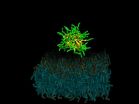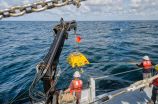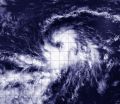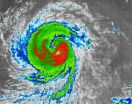(Press-News.org) DURHAM, N.C. -- New methods for analyzing personal health and lifestyle data captured through wearable devices or smartphone apps can help identify college students at risk of catching the flu, say researchers at Duke University and the University of North Carolina-Chapel Hill.
With help from a mobile app that monitors who students interact with and when, epidemiologist Allison Aiello of UNC and statistician Katherine Heller of Duke have developed a model that enables them to predict the spread of influenza from one person to the next over time.
Unlike most infection models, which focus on population-level changes in the proportion of people likely to get sick, this approach gives a personalized daily forecast for each patient, Heller said.
In theory, doctors could use such data to identify and alert at-risk students before they get sick or start to feel symptoms, or to encourage them to stay at home to avoid infecting other students.
The researchers presented their findings Aug. 12 at the 21st International Conference on Knowledge Discovery and Data Mining in Sydney, Australia.
Although this year's flu season won't reach its peak until the winter, it starts to ramp up as early as October, and college campuses nationwide are getting ready. Close living quarters, low flu vaccination rates and busy social calendars make college students particularly prone to catching the virus.
Of the nation's 18 million undergraduates, more than one in five are likely to get the flu this year. That could mean up to two weeks of fever, chills, muscle aches, scratchy throat, runny stuffy nose, congestion and sneezing, not to mention missed classes and extracurriculars.
To test the model, the researchers applied it to a study of roughly 100 students at the University of Michigan.
For 10 weeks during the 2013 flu season, the students carried Google Android smartphones with built-in software, iEpi, that used Wi-Fi, Bluetooth and GPS technology to monitor where they went and who they came in contact with from moment to moment.
The students also recorded their symptoms every week online. Students who reported coughing and fever, chills or aches provided throat swabs to determine whether they had a cold or the flu.
The model then returned the odds that each student would spread or contract the flu on a given day, and identified the personal health habits -- such as hand-washing or getting a flu shot -- that might help them beat the odds or hasten their recovery.
Not surprisingly, when a student got sick, his or her friends were more likely to get sick too.
The researchers also found that students who smoked or drank took longer to recover.
"We didn't have this kind of personalized health data until a few years ago," Heller said. "But now, smartphones and wearable health and fitness devices allow us to collect information like a person's heart rate, blood pressure, social interactions and activity levels with much more regularity and more accurately than was possible before. You can keep a continuous logbook."
"We want to leverage that data to predict what people's individual risk factors are, and give them advice to help them reduce their chances of getting sick," Heller said.
Kai Fan of Duke and Marisa Eisenberg and Alison Walsh of the University of Michigan were also authors of this study. This work was supported by the U.S. National Science Foundation (Grant no. 3331830) and the U.S. Centers for Disease Control and Prevention (U01CK00018).
# # #
CITATION: "Hierarchical Graph-Coupled HMMs for Heterogeneous Personalized Health Data," K. Fan, M. Eisenberg, A. Walsh, K. Heller and A. Aiello. Proceedings of the 21th ACM SIGKDD International Conference on Knowledge Discovery and Data Mining, August 2015.
DOI: 10.1145/2783258.2783326.
INFORMATION:
Imagine staying dry underwater for months. Now Northwestern University engineers have examined a wide variety of surfaces that can do just that -- and, better yet, they know why.
The research team is the first to identify the ideal "roughness" needed in the texture of a surface to keep it dry for a long period of time when submerged in water. The valleys in the surface roughness typically need to be less than one micron in width, the researchers found. That's really small -- less than one millionth of a meter -- but these nanoscopic valleys have macroscopic impact.
Understanding ...
(SACRAMENTO, Calif.) -- In a discovery that is likely to rewrite immunology text books, researchers at UC Davis have found that early exposure to inflammatory cytokines, such as interleukin 2, can "paralyze" CD4 T cells, immune components that help orchestrate the body's response to pathogens and other invaders.
This mechanism may act as a firewall, shutting down the immune response before it gets out of hand. However, from a clinical standpoint, this discovery could lead to more effective cancer immunotherapies, better drugs for autoimmune conditions and new ways to ...
Scientists are planning for a future in which superbugs gain the upper hand against our current arsenal of antibiotics. One emerging class of drug candidates, called AMLPs (antimicrobial lipopeptides), shows promise, and an August 18 study in the Biophysical Journal explains why: they selectively kill bacterial cells, while sparing mammalian host cells, by clumping together into microscopic balls that stick to the bacterial membrane--a complex structure that will be slower to mutate and thus resist drugs.
"The pressing need for novel antibiotics against resistant strains ...
SAN FRANCISCO--Early data coming in from a massive, four-year deployment of seismometers onshore and offshore in the Pacific Northwest are giving scientists a clearer picture of the Cascadia subduction zone, a region with a past and potential future of devastating "megathrust" earthquakes.
The preliminary results from the Cascadia Initiative include a report of previously undetected, small earthquakes offshore, and seismic imaging that reveals new offshore structures at the subduction zone. The reports, published as a focus section in the September-October 2015 issue ...
Research indicates that the use of condoms may cause some men to experience erection difficulties. However, in a study of 479 heterosexual men who used condoms and were 18 to 24 years old, those who reported condom-associated erection problems were also more likely to experience more generalized erection difficulties.
Investigators also found that more than one-third of participants had never been taught how to use a condom correctly. Clinicians should assess whether men using condoms experience condom-associated erection problems and where appropriate, make referrals ...
Liver diseases affect hundreds of millions of people and cause significant illness and death. A new study indicates that liver scarring (or fibrosis), which can ultimately lead to liver failure, is fairly common. It was present in 5.6% of adults in the Rotterdam Study, a population-based study among individuals in a suburb of Rotterdam, the Netherlands, who were ?45 years old. It was especially prevalent in individuals with diabetes or steatosis, the latter of which occurs when fat cells infiltrate the liver.
"In the context of an aging population and an increasing prevalence ...
New research indicates that use of oral contraceptives may provide benefits for women with inflammatory arthritis.
Among 273 women with early inflammatory arthritis, women who had used oral contraceptives in the past and those who were currently using them reported fewer problems related to how well they can function, their mood, and how active their disease is.
The findings are published in Arthritis Care & Research.
INFORMATION: ...
It's known that brain changes are present in drug addicts even when they have been abstinent for a short period of time. Now new research shows that alterations persist in long-term abstinent heroin-depended individuals as well.
Through the use of functional magnetic resonance imaging, investigators analyzed the brains of 30 heroin-addicted individuals after a long period of abstinence (more than 3 years) and compared the results with those of 30 healthy controls.
The team found that in the former heroin users, there was significant dysfunctional activity in the nucleus ...
The fourth tropical depression of the Atlantic Ocean hurricane season formed today, August 18, 2015 as NASA's Terra satellite passed overhead.
On Aug. 18 at 8:45 a.m. EDT the Moderate Resolution Imaging Spectroradiometer or MODIS instrument aboard NASA's Terra satellite captured a visible image of newborn Tropical Depression 4 in the central Atlantic Ocean. The image showed thunderstorms banding around the center of circulation in all quadrants except the northwest.
The National Hurricane Center (NHC) also uses measurements from the Advanced Scatterometer or ASCAT instrument ...
NASA-NOAA's Suomi NPP satellite passed over Typhoon Goni and gathered infrared data that helped identify the strongest part of the storm as the south and eastern quadrants.
The Visible Infrared Imaging Radiometer Suite (VIIRS) instrument aboard NASA-NOAA's Suomi satellite captured an infrared image of Goni on August 18 at 4:18 UTC (12:18 a.m. EDT) that showed the strongest thunderstorms with the coldest cloud top temperatures (near -63F/-53C) were in the eastern and southern quadrants.
The Joint Typhoon Warning Center noted that animated enhanced infrared satellite ...



